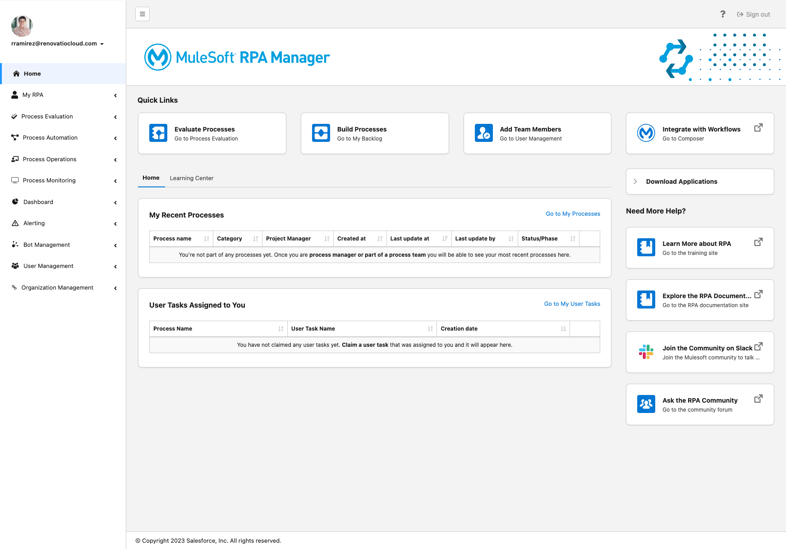Robotic Process Automation (RPA) Explained
.png) by
Raul Ramirez
by
Raul Ramirez
Over the past three years, companies of all sizes and industries have undergone tremendous change. The global COVID-19 pandemic and related lockdowns forced companies to embark and deliver 2-3 years of digital transformation initiatives in less than a couple of months. However, even as the global pandemic subsided, new headwinds, including macro-economic uncertainty, labor shortages, disruptions to the global supply, and geopolitical unrest, rapidly emerged. As such, companies have quickly realized that their digital transformation journeys are not even close to the finish line, but rather just starting to begin.
Intelligent automation is a key pillar in the path forward to accelerating digital transformations. One of the fastest growing segments of the software market and one of the key technologies enabling intelligent automation is robotic process automation (RPA).
WHAT IS RPA AND HOW DOES IT WORK?
Robotic process automation (RPA) is a software technology that allows businesses to automate repetitive, mundane tasks through the use of software robots, or "bots." These bots can emulate human actions, such as clicking through a website or filling out a form, and can be programmed to perform these actions at scale, freeing up employees to focus on more complex, value-adding work. For the most part, the use of RPA does not require any changes to existing software applications and systems, since a software robot works in a comparable way on the user interface as a human would. RPA solutions can run on individual desktop PCs as well as on corporate servers. 
WHAT BENEFITS ARE ASSOCIATED WITH RPA?
One of the main benefits of RPA is its ability to improve efficiency and reduce errors. By automating repetitive tasks, businesses can reduce the likelihood of errors caused by human fatigue or lack of attention to detail. Additionally, RPA bots can work 24/7, which allows businesses to increase productivity and throughput without the need to hire additional staff.
Another benefit of RPA is its ability to improve compliance and reduce risk. For example, in industries such as finance and healthcare, compliance with regulations is essential. RPA can be used to automate the process of checking for compliance, reducing the risk of non-compliance and the associated penalties.
RPA also offers cost savings for businesses. By automating repetitive tasks, businesses can reduce labor costs and increase productivity. Additionally, RPA can be integrated with other technologies, such as artificial intelligence (AI) and machine learning (ML), to further improve efficiency and reduce costs.
WHAT CHALLENGES ARE ASSOCIATED WITH RPA?
Despite the benefits of RPA, there are also challenges that businesses need to be aware of when implementing the technology. One of the main challenges is the potential for job loss as a result of automation. However, businesses can mitigate this by retraining employees for roles that cannot be automated, such as those that require creativity or empathy.
Another challenge is the potential for a lack of transparency in the decision-making process of RPA bots. This can be addressed by implementing proper monitoring and auditing systems to ensure that the bots are making the correct decisions.
There is also a challenge of scalability, as the implementation of RPA requires significant resources and expertise. However, many RPA vendors offer support and services to help businesses with the implementation process.
HOW DO API-LED CONNECTIVITY AND RPA COMPLEMENT EACH OTHER?
Many business stakeholders believe RPA and APIs are at odds with each other, as APIs enable systems and data integration while RPA transfers data between systems. However, in certain cases, an API-led approach can work with RPA to expand integration and access to more endpoints. RPA can also be utilized when an API-led approach is not feasible for business process automation, such as when a system has no API, is a legacy or on-premises application, or is heavily customized for an organization. Additionally, RPA can be used as a temporary solution for access to a system when there is a delay or lack of investment in creating an API endpoint. Furthermore, RPA can also be used when different teams are managing automation and integration.
CLOSING THOUGHTS
Overall, RPA is a valuable technology for businesses looking to improve efficiency, reduce errors, and comply with regulations. However, businesses need to be aware of the challenges associated with implementation and take steps to mitigate them.
Despite the challenges, the adoption of RPA is increasing rapidly as more and more businesses are realizing the potential benefits. As the technology continues to evolve, we can expect to see even more advanced capabilities and use cases in the future.
One possible area of future growth for RPA is the integration with other technologies, such as AI and ML. By combining the capabilities of RPA with these technologies, businesses can create intelligent automation systems that can adapt to changing circumstances and make decisions based on data analysis.
Another area of future growth is the use of RPA in industries beyond traditional office work such as retail, healthcare and manufacturing, where the technology can be used to automate tasks such as inventory management, patient care and quality control.
In conclusion, robotic process automation is a game-changer for businesses. It allows them to automate repetitive, mundane tasks, improve efficiency, reduce errors, and comply with regulations. The technology also offers cost savings and increased productivity. However, businesses need to be aware of the challenges associated with implementation and take steps to mitigate them. As the technology continues to evolve, we can expect to see even more advanced capabilities and use cases in the future.
